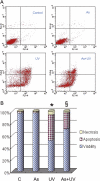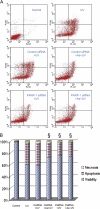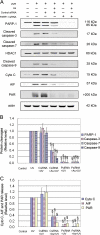Poly(ADP-ribose) polymerase-1 inhibition by arsenite promotes the survival of cells with unrepaired DNA lesions induced by UV exposure
- PMID: 22387748
- PMCID: PMC3327874
- DOI: 10.1093/toxsci/kfs099
Poly(ADP-ribose) polymerase-1 inhibition by arsenite promotes the survival of cells with unrepaired DNA lesions induced by UV exposure
Abstract
Human arsenic exposure is associated with increased risk of skin cancer, and arsenite greatly enhances ultraviolet (UV)-induced skin tumors in a mouse model of carcinogenesis. Inhibition of DNA repair is one proposed mechanism for the observed cocarcinogenicity. We have previously demonstrated that low concentrations of arsenite inhibit poly(ADP-ribose) polymerase (PARP)-1, thus interfering with DNA repair process triggered by UV radiation. Because overactivation of PARP-1 often leads to apoptotic cell death, and unrepaired DNA lesions promote genomic instability and carcinogenesis, we hypothesized that inhibition of PARP-1 by arsenic may promote the survival of potentially "initiated carcinogenic cells," i.e., cells with unrepaired DNA lesions. In the present study, we tested this hypothesis on UV-challenged HaCat cells. Cells were pretreated with 2μM arsenite for 24 h before UV exposure. Outcome parameters included apoptotic death rate, PARP-1 activation, apoptotic molecules, and retention of DNA lesions. UV exposure induced PARP-1 activation and associated poly(ADP-ribose) production, apoptosis-inducing factor release, cytochrome C release, and caspases activation, which led to apoptotic death in HaCat cells. Pretreatment with 2μM arsenite significantly inhibited UV-induced cell death as well as the associated molecular events. Notably, knockdown of PARP-1 with small interfering RNA completely abolished the antagonism of arsenite. Furthermore, arsenite pretreatment led to long-term retention of UV-induced cyclobutane pyrimidine dimers. Together, these results suggest that low concentration of arsenite reduces UV-induced apoptosis via inhibiting PARP-1, thus promoting the survival of cells with unrepaired DNA lesions, which may be an important mechanism underlying arsenic cocarcinogenic action.
Figures







Similar articles
-
Inhibition of poly(ADP-ribose) polymerase-1 by arsenite interferes with repair of oxidative DNA damage.J Biol Chem. 2009 Mar 13;284(11):6809-17. doi: 10.1074/jbc.M805566200. Epub 2008 Dec 3. J Biol Chem. 2009. PMID: 19056730 Free PMC article.
-
Low concentration of arsenite exacerbates UVR-induced DNA strand breaks by inhibiting PARP-1 activity.Toxicol Appl Pharmacol. 2008 Oct 1;232(1):41-50. doi: 10.1016/j.taap.2008.05.019. Epub 2008 Jul 10. Toxicol Appl Pharmacol. 2008. PMID: 18619636 Free PMC article.
-
Arsenite binding-induced zinc loss from PARP-1 is equivalent to zinc deficiency in reducing PARP-1 activity, leading to inhibition of DNA repair.Toxicol Appl Pharmacol. 2014 Jan 15;274(2):313-8. doi: 10.1016/j.taap.2013.11.010. Epub 2013 Nov 22. Toxicol Appl Pharmacol. 2014. PMID: 24275069 Free PMC article.
-
Poly(ADP-ribose) Polymerase (PARP) and PARP Inhibitors: Mechanisms of Action and Role in Cardiovascular Disorders.Cardiovasc Toxicol. 2018 Dec;18(6):493-506. doi: 10.1007/s12012-018-9462-2. Cardiovasc Toxicol. 2018. PMID: 29968072 Review.
-
Modulating poly (ADP-ribose) polymerase activity: potential for the prevention and therapy of pathogenic situations involving DNA damage and oxidative stress.Curr Pharm Biotechnol. 2002 Sep;3(3):275-83. doi: 10.2174/1389201023378265. Curr Pharm Biotechnol. 2002. PMID: 12164482 Review.
Cited by
-
Nicotinamide enhances repair of arsenic and ultraviolet radiation-induced DNA damage in HaCaT keratinocytes and ex vivo human skin.PLoS One. 2015 Feb 6;10(2):e0117491. doi: 10.1371/journal.pone.0117491. eCollection 2015. PLoS One. 2015. PMID: 25658450 Free PMC article.
-
Maternal arsenic exposure and DNA damage biomarkers, and the associations with birth outcomes in a general population from Taiwan.PLoS One. 2014 Feb 18;9(2):e86398. doi: 10.1371/journal.pone.0086398. eCollection 2014. PLoS One. 2014. PMID: 24558361 Free PMC article.
-
Impacts of arsenic on Rad18 and translesion synthesis.Toxicol Appl Pharmacol. 2022 Nov 1;454:116230. doi: 10.1016/j.taap.2022.116230. Epub 2022 Sep 8. Toxicol Appl Pharmacol. 2022. PMID: 36087615 Free PMC article.
-
Monomethylarsonous acid (MMA+3) Inhibits IL-7 Signaling in Mouse Pre-B Cells.Toxicol Sci. 2016 Feb;149(2):289-99. doi: 10.1093/toxsci/kfv233. Epub 2015 Oct 30. Toxicol Sci. 2016. PMID: 26518055 Free PMC article.
-
Environmentally Relevant Concentrations of Arsenite Induce Dose-Dependent Differential Genotoxicity Through Poly(ADP-Ribose) Polymerase Inhibition and Oxidative Stress in Mouse Thymus Cells.Toxicol Sci. 2016 Jan;149(1):31-41. doi: 10.1093/toxsci/kfv211. Epub 2015 Oct 5. Toxicol Sci. 2016. PMID: 26443841 Free PMC article.
References
-
- Agency for Toxic Substances and Disease Registry (ATSDR) Toxicological Profile for Arsenic. Atlanta, GA: U.S. Department of Health and Human Services, Public Health Service; 2007. - PubMed
-
- Beyersmann D, Hartwig A. Carcinogenic metal compounds: Recent insight into molecular and cellular mechanisms. Arch. Toxicol. 2008;82:493–512. - PubMed
Publication types
MeSH terms
Substances
Grants and funding
LinkOut - more resources
Full Text Sources
Miscellaneous

